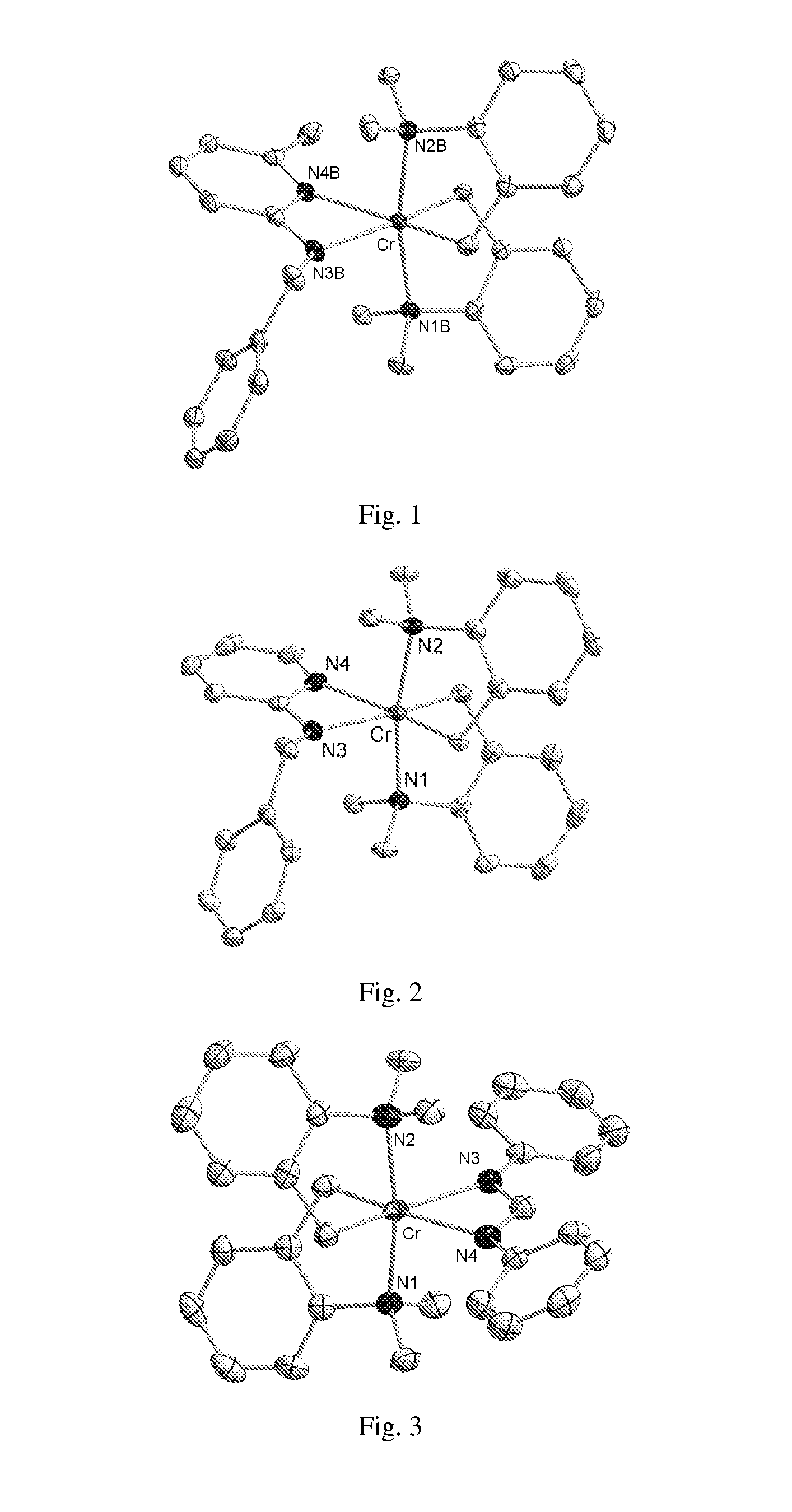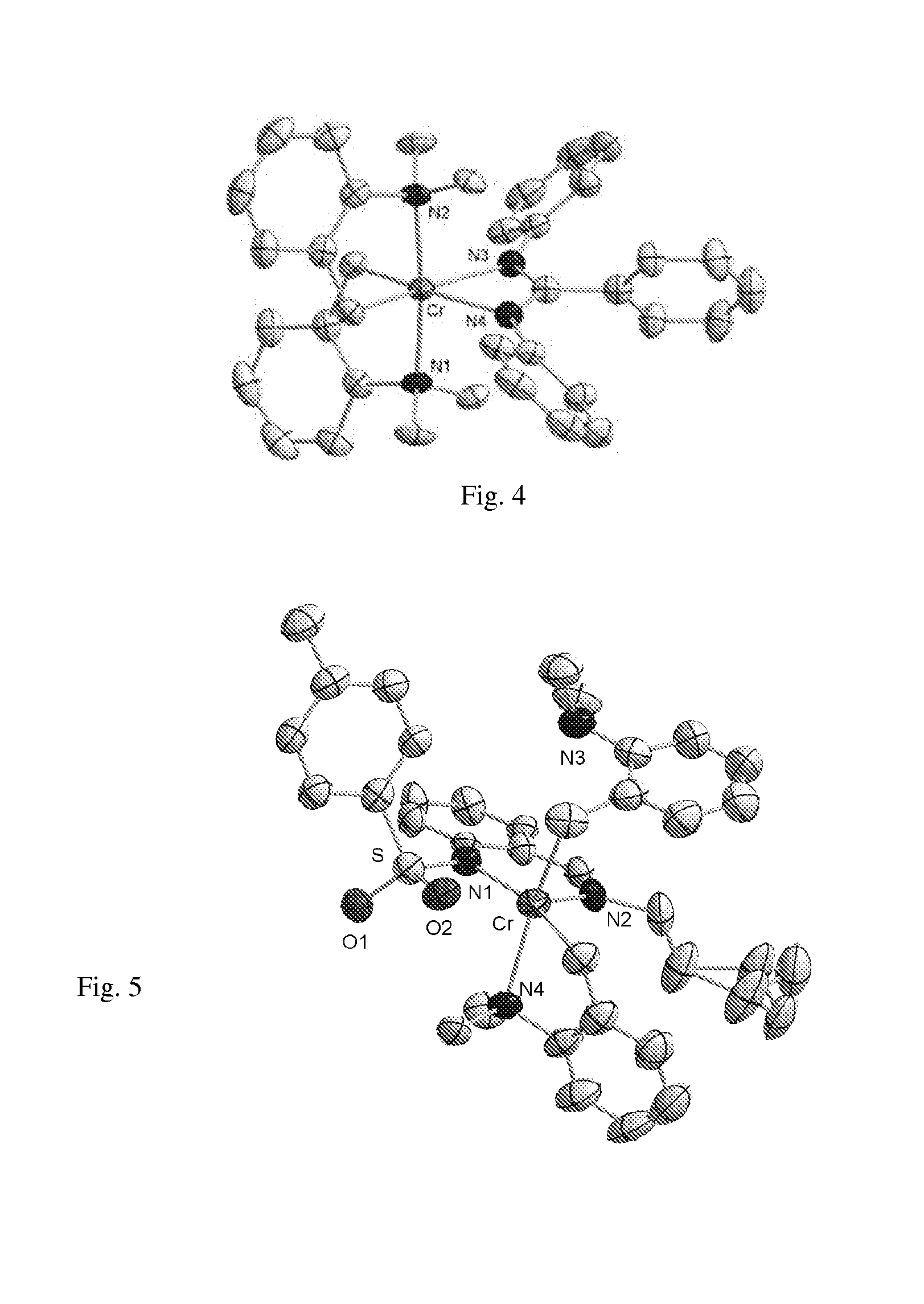Non-cyclopentadienyl-based chromium catalysts for olefin polymerization
- Summary
- Abstract
- Description
- Claims
- Application Information
AI Technical Summary
Benefits of technology
Problems solved by technology
Method used
Image
Examples
example 1
Preparation of Chromium Complex (1)
[0073]
[0074]Add N-benzyl-6-methylpyridin-2-amine (7.603 g, 16.72 mmol) in benzene (100 mL) dropwise to a solution of chromium complex (a1) in benzene (200 mL) with stirring. Stir the mixture for an additional hour. Remove volatiles from the reaction mixture under vacuum, and dissolve the residue in hexane. Warm the solution to 60° C. for a short time to aid dissolution, filter through a combination frit 20 μm PE pre-frit and 1 μm PTFE final frit), and place the filtrate solution in the freezer (−10° C.) overnight, during which time red crystals form. Isolate the crystals by decanting of the liquid to give complex (1) (6.705 g, 77.5%). FIG. 1 depicts an ORTEP of a single crystal structure derived by x-ray analysis of invention complex (1) with hydrogen atoms omitted for clarity.
example 2
Preparation of Chromium Complex (2)
[0075]
[0076]Add N-benzylpyridin-2-amine (0.173 g, 0.38 mmol) in D6-benzene (5 mL) dropwise to a solution of chromium complex (a1) in D6-benzene (5 mL) with stirring. NMR of an aliquot indicates that the reaction has already occurred since all that is observed free from Cr as evidenced by the dimagnatism is the N,N,2-trimethylaniline by-product. Remove volatiles from the reaction mixture under vacuum, and dissolve the residue in methylcyclohexane. Warm the solution to 60° C. for a short time to aid dissolution, filter through a combination frit 20 μm PE pre-frit and 1 μm PTFE final frit), and place the filtrate solution in the freezer (−10° C.) overnight, during which time red / brown crystals form. The Carefully dry the crystals by blowing N2 gas over them for a short time to give complex (2). Obtain a second crop of crystals. Further drying of the material results in the isolation of complex (2) as a red / brown crystalline solid (0.106 g, 55.8%). Gro...
example 3
Preparation of Chromium Complex (3)
[0077]
[0078]Add chromium complex (a1) (0.100 g, 0.22 mmol) and (E)-N,N′-diphenylformimidamide (0.043 g, 0.22 mmol) together in a reaction vessel as solids followed by D6-benzene (10 mL). The solids immediately dissolve. NMR analysis of the solution indicates that the reaction is complete. Remove volatiles from the reaction mixture under vacuum, and dissolve the residue in methylcyclohexane. Warm the solution to 50° C. for a short time to aid dissolution, filter through a combination frit 20 μm PE pre-frit and 1 μm PTFE final frit), and place the filtrate solution in the freezer (−10° C.) overnight. Clear red crystals precipitate and are isolated by decanting of the liquor. Dry the crystals carefully by blowing N2 gas over them for a short time. Further drying of the material results in the isolation of complex (3) as a red crystalline solid (0.0642 g, 56.8%). FIG. 3 depicts an ORTEP of a single crystal structure derived by x-ray analysis of inventi...
PUM
| Property | Measurement | Unit |
|---|---|---|
| Percent by mass | aaaaa | aaaaa |
| Fraction | aaaaa | aaaaa |
| Fraction | aaaaa | aaaaa |
Abstract
Description
Claims
Application Information
 Login to View More
Login to View More - R&D
- Intellectual Property
- Life Sciences
- Materials
- Tech Scout
- Unparalleled Data Quality
- Higher Quality Content
- 60% Fewer Hallucinations
Browse by: Latest US Patents, China's latest patents, Technical Efficacy Thesaurus, Application Domain, Technology Topic, Popular Technical Reports.
© 2025 PatSnap. All rights reserved.Legal|Privacy policy|Modern Slavery Act Transparency Statement|Sitemap|About US| Contact US: help@patsnap.com



